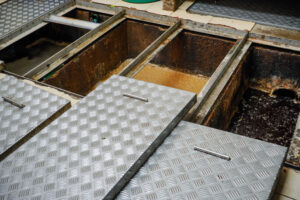
How Do Grease Trap Work?
Various establishments need grease traps for their large kitchens. Schools, businesses, and hospitality services use these traps to contain waste, grease, and other things that shouldn’t go down a drain. Some people, particularly restaurant workers, have had the unfortunate experience of dealing with a full or broken grease trap. The bright side of that fact, is that when you understand how a grease trap works, it’s easier to keep it in good condition and working properly.
Different Types of Grease Traps
Different buildings and kitchens have varying functions, so there are two choices when it comes to a grease trap. Smaller traps, point-of-use traps, are small grease traps, which attach to lines for specific devices. Large traps, or interceptors, can hold grease and debris from a commercial kitchen, and they can contain up to 500 gallons.
Fat, oil, and grease build up in grease traps, most people in the industry refer to this as FOG. Grease traps collect solids as well. Grease traps prevent FOG and large debris from contaminating sewer lines, and they’re usually required for each kitchen.
A grease trap is not directly connected to the appliance it needs to filter. There is a control valve; it prevents the water from hitting the grease trap too fast. This distance allows the water to cool on the way to the trap. Two things happen at this time.
- The food debris sinks
- FOG floats
The control keeps the water from clearing the debris away from the trap, and the well keeps the FOG floating by filling the well with water. The FOG doesn’t travel to the drain, and the food debris sinks below the drain, leaving a clear path for uncontaminated water.
If you’re looking to maintain your grease trap, don’t hesitate to reach out to us. Contact Freedom Septic Service at 410-795-2947 today or visit us online for more information!

Leave a Reply
You must be logged in to post a comment.